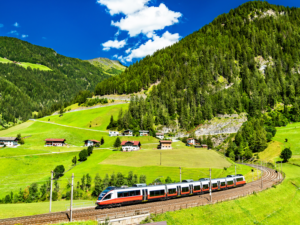Ranked and rated: Europe’s best and worst countries for train travel
16 min readAll travellers like trains. European travellers love them. An InterRail trip is a rite of passage that stays in the memory. The Eurostar is to millennials what boat trains were for Gen X: a portal to an entire continent. European railway stations – usually prominent, often palatial – suggest history and romance. They feature in classic films, novels and music. In a climate-conscious world, railways remain the greenest alternative. They are safer and cause less stress than driving. For anyone keen to see the world, is there any better place than beside a train window?
So, with this in mind, we’ve taken the rail networks of Europe’s 15 largest (open) countries to task, rating each one on the factors that matter most. Read on to find out which ailing national networks are best avoided (and those with a highlight that’s nevertheless worth the hassle), and which are the finest options for a successful rail-based escape – whether it be your next spring city break, or a glorious weeks-long odyssey that snakes from coast to countryside.
15. Greece
Bringing up the rear in our ranking is this snaking country of jagged coasts, islands, mountains and peninsulas, which has never quite made the railways work for its people. There are trains every few hours linking Athens and Thessaloniki (under five hours), but much of the timetable is spattered with dreaded rail replacement buses. Floods in 2023 have led to a near collapse of the network. Toy trains operate in some touristy areas, such as the Odontotos rack railway – though that was recently stopped by landslides. Athens used to luxuriate in services to Berlin and was once a branch of the Orient Express. There were trains to Turkey via Pythio and North Macedonia via Idomeni. The pandemic shut down what was already a dwindling service and international lines to Sofia, Skopje and Bucharest remain closed. Athens has the most underwhelming main station of any country in Europe – which sort of sums things up.
- Miles of railway per sq mile: 5/10
- Sleeper services: 0/10
- Beautiful stations: 2/10
- Punctuality/average delays: 9/10
- Cost: 7/10
- Scenic prowess: 5/10
Total: 28/60
14. Bulgaria
With no current connections to Belgrade or Greece, Sofia is not the international hub it used to be. It’s still the place to catch a sleeper train to Asia, albeit by means of a daily service to Halkali – the new pseudo-station for Istanbul (10 miles away).

For touring this Black Sea nation there are regular if not ultra-frequent services, day and night, to Varna and Burgas. Bulgaria is trainspotter heaven with Soviet-era Ludmilla locos still pulling passenger trains. Railway workers wryly refer to stations as “hangars” but Sofia’s main terminal is a Brutalist masterpiece.
- Miles of railway per sq mile: 5/10
- Sleeper services: 5/10
- Beautiful stations: 1/10
- Punctuality/average delays: 7/10
- Cost: 6/10
- Scenic prowess: 5/10
Total: 29/60
13. Norway
Norway has a relatively small network for its vast size, though we should take into account its sparse population in some areas. Capacity issues are a problem on some lines, and rail travel is expensive. Punctuality is fair to middling, but trains are quite slow, partly because of terrain. The only high-speed train is to the airport. Many Norwegians use planes for long distances and cars for A to B, but rail opens up epic journeys and extreme locations.

Narvik isn’t the most northerly station in the world, but it’s the most northerly one you’ll want to visit – unless your idea of a holiday is riding Russian lines to see a Gazprom plant. Irritatingly for Norwegians, any journey this far north involves travel through Sweden. Within Norway, sleeper trains operate from Oslo to Bergen, Stavanger and Trondheim. But taking the daylight service to the latter, along the Dovre line via Gudbrandsdalen, Rondane and Dovrefjell, means you don’t miss views of the extraordinary national parks. A 71-mile spur from Dombås called the Rauma Line is one of the country’s stunners; the area around Bjorli was used for a scene in Harry Potter and the Half Blood Prince.
- Miles of railway per sq mile: 4/10
- Sleeper services: 5/10
- Beautiful stations: 2/10
- Punctuality/average delays: 8/10
- Cost: 3/10
- Scenic prowess: 8/10
Total: 30/60
12. Spain
AVE trains – capable of over 190 mph – link Madrid to Barcelona, Malaga, Granada, Seville, Alicante, Murcia, Valencia and Ourense in Galicia. In this large country with its capital bang in the middle, high-speed rail has been transformative. On board, the trains are plasticky and soulless, like most modern rolling stock, and WiFi is patchy and diesel-speed. You get a sense of Spain’s scale, agriculture and general contours from an AVE, but slower services are recommended if you want to take in the landscapes of Asturias or Extremadura.

State-owned operator Renfe runs the luxury Transcantábrico metre-gauge line between Bilbao and Ferrol, but there are ordinary public services along much of the route. Pricing in Spain is dynamic and last-minute tickets are usually expensive. Avlo’s low-cost, high-speed services were introduced in 2018 and you can get a Madrid-Barcelona one-way ticket for €15 (£12.80) (2h 30, 314 miles). The purple-liveried trains have only tourist class seats, no quiet car and don’t allow pets.
Barcelona has thrice-daily daytime services to Paris, but sleeper fans miss the Elipsos Trenhotel services to Milan, Paris and Zurich, axed in 2012-3. Spain is not well connected to the rest of Europe and there are huge areas of its own territory that are far from a railway station.
- Miles of railway per sq mile: 5/10
- Sleeper services: 3/10
- Beautiful stations: 4/10
- Punctuality/average delays: 8/10
- Cost 6/10
- Scenic prowess: 5/10
Total: 31/60
11. Sweden
Swedish train tickets are among the most expensive in Europe. Punctuality recently fell to a record low (since 2001), with only 88 per cent of services on time; the Malmo-Stockholm service operated by Snälltåget was the worst. Factor in ageing rolling stock and dirty, run-down carriages on state-owned SJ routes, and you might think of sticking to planes or a car. But Sweden is big and has some beautiful lines.

Two classics include the 18-hour, 630-mile year-round Stockholm-Luleå-Narvik sleeper train – also known as the Arctic Circle train, run by Vy Tåg; and the epic Inlandsbanan line, a rural railway that connects Mora in central Sweden to Gällivare in Swedish Lapland – and is best enjoyed as a series of overnight stops.
Looking south, in September 2023, SJ announced that its overnight service from Stockholm to Berlin would operate year-round. Snälltåget competes on the route in spring and summer and its shared couchettes are a third cheaper. Another “low-cost operator”, FlixTrain, began running services between Stockholm and Gothenburg in 2021.
- Miles of railway per sq mile: 5/10
- Sleeper services: 6/10
- Beautiful stations: 3/10
- Punctuality/average delays: 8/10
- Cost: 2/10
- Scenic prowess: 7/10
Total: 31/60
10. Hungary
With seven countries on its border, smallish Hungary is criss-crossed by international services. Those to Vienna and Munich provide quick routes into Western Europe, day or night, and Budapest is well connected to Romania. Nightjet runs sleepers to Slovakia and Berlin, Salzburg and Zurich, and Stuttgart.

The country is not huge and it’s well covered by domestic inter-cities and branch lines. Crossing from one side to the other can take all day, but there are several picturesque stretches, such as the one to Lake Balaton. Budapest Keleti is a handsome station, featuring statues of James Watt and George Stephenson.
- Miles of railway per sq mile: 8/10
- Sleeper services: 5/10
- Beautiful stations: 4/10
- Punctuality/average delays: 3/10
- Cost: 6/10
- Scenic prowess: 6/10
Total: 32/60
9. Poland
Functionalist Warsaw Central, opened in 1975, makes you think of the B-side of Bowie’s Cold War concept album Low. By (sort of) contrast, Polish provincial stations have an olden-days quality. Between city termini run slow express trains and no high-speed lines whatsoever. The Union Jack on the website of state monopoly PKP’s putative booking site doesn’t change the language. Somehow train travel opens up the national soul and the lines to Belarus and Russia (closed), to Gdansk and Krakow and to Oswiecim (Auschwitz) are freighted with history. For all that, we have to face up to the very present-day reality of rail travel in Poland.

Lithuania, too small for our survey, has the most expensive rail services in Europe. Next comes: Poland. Why? The operator blames high electricity prices, inflation and interest rates. Increases above 17 per cent on inter-city routes were recently announced. But trains go in all directions from Warsaw to the edges of the nation, including county-crossing night trains between Kolobrzeg and Krakow and Swinoujscie and Przemysl Glowny (with connections to Kyiv). EuroNight’s recently launched Warsaw-Munich sleeper connects the Polish capital with Krakow, Salzburg, Vienna and Munich – with sections for Prague and Budapest. Day trains run between all cities and towns. In May 2023, PKP announced Poland’s first train featuring panoramic windows, connecting Przemysl with the Austrian city of Graz.
- Miles of railway per sq mile: 7/10
- Sleeper services: 6/10
- Beautiful stations: 5/10
- Punctuality/average delays: 9/10
- Cost 2/10
- Scenic prowess: 4/10
Total: 33/60
8. UK
London is well served by inter-city and regional lines. The rest of the UK is, at best, satisfactorily plugged into the capital, but nowhere else. Parts of northern England, rural Scotland and rural Northern Ireland are rail deserts. Because of its location, closer to France than to Bristol, London has umpteen termini and no central station; switching networks is a pain.
Across the country, the further you get from metropolitan sprawls, the more desultory the rail offering; some regional operators – notably Northern – fail to maintain a reliable and punctual service. From a tourism point of view, there are some alluring scenic routes, especially in the Highlands of Scotland, along the Devon coast and across Wales, but the two sleeper routes (to Cornwall and Scotland) only work for Londoners and residents of Cornwall and the Highlands.

Rail travel in the UK is expensive; no longer audited by the EU, its average prices match those of Norway and Poland. Last minute booking is impossible except for the rich. HS1, linking London and Ashford in Kent, is not exactly the poster-child the country that created railways needs. But Britain is not as badly connected as some people think. Nor are all lines slow. Warrington to London Euston trains run non-stop every hour, taking just 1h 47 mins. Proof that we didn’t need HS2 all along? Perhaps. The UK has some picturesque stations, reaches many corners of the nation and has heaps of history, but could easily be the best network in Europe if it weren’t let down by mismanagement and a maddening pricing and booking regime.
- Miles of railway per sq mile: 8/10
- Sleeper services: 2/10
- Beautiful stations: 6/10
- Punctuality/average delays: 8/10
- Cost: 3/10
- Scenic prowess: 5/10
Total: 34/60
7. Romania
Bram Stoker’s Dracula opens and closes with atmospheric train journeys across the Carpathians. This is a country for slow, scenic rides, socialising, a bit of patience and packed lunches. Currently modernising its rolling stock, Romania’s rail operator CFR doesn’t do luxury or high speed; trains stop often and the terrain is mountainous in many parts. Romania is a similar size to the UK, but has almost 3,000 more miles of railway and is ranked second from top for coverage in this survey. A good range of sleeper trains connect the main cities. Connections to Serbia and Greece are currently suspended because of construction works and operational issues, but Bucharest has decent daytime connections to Budapest via Timisoara and a night train (346/7) to Vienna.
While direct trains to Istanbul are indefinitely off the cards, you can crawl to Turkey via Gorna and Dimitrovgrad. Romania’s booking website, cfrcalatori.ro, should be on all the induction courses for European rail staff; it is easy to use and shows a simple map of your journey; wheels spin gaily as it searches for your service. Some rural stations – like Sinaia – are quaint and city stations can be grand, as is the case with Cluj-Napoca. But Soviet-era “upgrades” have left their mark all over.
- Miles of railway per sq mile: 9/10
- Sleeper services: 7/10
- Beautiful stations: 5/10
- Punctuality/average delays: 2/10
- Cost: 4/10
- Scenic prowess: 8/10
Total: 35/60
6. Italy
Long and skinny, with several major urban centres spaced well apart, Italy is ideal for train travel. Regular, generally punctual Frecciarossa (“red arrow”) trains, capable of 300km/h (186mph) connect Venice, Milan, Naples, Bolzano and Genova along the main ultra-high-speed west coast route. An ordinary high-speed line runs down the opposite coast. East-west connections tend to be slower and it’s still quite an odyssey to go all the way to the toe of the boot and cross over to Sicily. The fastest journey from Milan to Palermo – which involves changing at Rome and/or Naples – takes upwards of 15 hours, with ferries conveying through-trains over the Straits of Messina.

Italy is normally well connected to countries to the north, but a landslide in August 2023 has closed the TGV line connecting Paris and Lyon to Milan, and ongoing work on the Gotthard Base Tunnel has affected services to Zurich. By the end of 2026, Frecciarossa trains will link Italy with Germany, though the current Munich-Verona-Bologna service (5.5 hours) is lovely precisely because it doesn’t go too fast through Upper Bavaria, the Tyrol and Alto Adige. There are Nightjet sleepers between Munich and both Rome and La Spezia and from Stuttgart to Venice and also from Vienna to all three Italian cities. Milan is one of Europe’s grandest railway palaces and there are many other imposing stations the length and breadth of this railway superpower.
- Miles of railway per sq mile 7/10
- Sleeper services: 7/10
- Beautiful stations: 6/10
- Punctuality/average delays: 7/10
- Cost: 3/10
- Scenic prowess: 6/10
Total: 36/60
5. Finland
Finland’s surface area is more than 130,000 square miles and it has a population of just 5.5 million people – a fifth of whom live in the capital region. Nonetheless, the state maintains a good, reliable service to all corners of the country except the very far north. Finnish trains are known for being clean, spacious, accessible and having fun playrooms for children. The booking website is beautifully smooth and simple.
Finland seems to have grasped the importance of rail to national tourism. Two night-trains run on weekdays from Helsinki to the northernmost station, Kolari – well above the Arctic Circle – which is useful for skiers; £148 for a bed for 14 hours is not bad at all. In summer, car transporters operate along the same route. As you’d expect, scenic journeys abound.
- Miles of railway per sq mile: 5/10
- Sleeper services: 5/10
- Beautiful stations: 7/10
- Punctuality/average delays: 9/10
- Cost: 5/10
- Scenic prowess: 7/10
Total: 38/60
4. Germany
The opening of Berlin Hbf in 2006 was an important symbol of German reunification. The impressive glass prism thrills to the constant passage of trains headed to the rest of the country and to Europe. Germany has eight of Europe’s 20 busiest stations to the UK’s five – but the German stations serve seven different cities while all the British ones are in London. A lot of journeys across Germany involve flat fields and grey skies, but the old, slow-paced Cologne-Mainz line along the left bank of the Rhine has great mountain and lake views – and some trains have panoramic windows. With just 64 per cent of long-distance trains reaching their destination on time (i.e. less than six minutes late) in 2023, the myth of German efficiency has imploded. But regional trains fared better (91 per cent were punctual).

Germany has the biggest rail network in Europe and its ICE trains are among the most dashing of the high-speeders. Its impressive stations reflect how important trains are to the putative “heart of Europe”; Leipzig Hauptbahnhof, the largest station in Europe, is where the Saxon and Prussian railways met and is a symbol of the city’s – and the nation’s – engineering prowess and pride. After its amazing €9 public transport giveaway of 2022, Germany has now committed long-term to the Deutschlandticket: a €49 (£42) monthly pass to use on regional trains as well as buses.
- Miles of railway per sq mile: 8/10
- Sleeper services: 4/10
- Beautiful stations: 7/10
- Punctuality/average delays: 8/10
- Cost: 7/10
- Scenic prowess: 6/10
Total: 40/60
3. Czech Republic
With 5,863 miles of track and a surface area of around 30,450 square miles, the Czech Republic has the second-highest density of railway in the world (after Switzerland). More than a third is electrified, but there are no high-speed lines. Punctuality is much better than in Germany and the fact that Czechs are heavy users of their network suggests they trust and rely on it. The easy-to-use website, cd.cz, shows the excellent services for getting around the country, with Prague in particular offering very frequent services to Dresden and Berlin, Vienna and Bratislava.
As well as Nightjet routes, the Belgian-Dutch cooperative European Sleeper (europeansleeper.eu), which launched a thrice-weekly night train between Berlin and Brussels in May 2023, has just extended the service to Prague and Dresden; it has ambitions to expand to Amsterdam and Barcelona.
The central station looks like a cathedral inside and the stations at Brno and Plzen are equally impressive. The Czech Republic has lots of lovely scenic routes, and has started to introduce panoramic windows on some lines. The dining cars on state-operated EuroCity trains have been praised by some travellers as Europe’s best restaurants on wheels, with regional food prepared fresh to order and bespoke-brewed craft beer.
- Miles of railway per sq mile: 10/10
- Sleeper services: 5/10
- Beautiful stations: 6/10
- Punctuality/average delays: 8/10
- Cost: 3/10
- Scenic prowess: 8/10
Total: 40/60
2. France
The arrival of the swaggering orange TGV in 1981 confirmed French railways as the new standard for Europe. Not since Japan’s shinkansen (bullet trains) had so much glamour been projected onto a railway track. Gare du Nord is Europe’s busiest railway station and Paris is a major hub for onward travel to Germany, Spain and Italy.

Night trains out of Gare d’Austerlitz connect the capital to Nice, Lourdes, Narbonne and, in summer, Hendaye (for San Sebastián). In December 2023, Austrian operator ÖBB started a Nightjet sleeper service between Paris and Berlin. Ten lost Intercités de Nuit routes are due to be relaunched by 2030 by the environmentally minded French ministry. Ouigo, France’s low-cost option – launched a decade ago – is the model other networks copy.
Beautiful stations, some delectable dining options – as on the TGV Lyria Franco-Swiss routes – and frequent, punctual services mean holidaying on French rail is a joy. Two caveats. While the high-speed services open up France, they also turn it into a blur. Some of the slower rolling stock is English-provincial-style awful, even in picturesque regions like the Côte d’Azur.
- Miles of railway per sq mile 7/10
- Sleeper services: 7/10
- Beautiful stations: 8/10
- Punctuality/average delays: 8/10
- Cost: 4/10
- Scenic prowess: 7/10
Total: 41/60
1. Austria
And now to the winner: punctual, pretty, practical Austria. Vienna is the main railway hub for Mitteleuropa, and while passenger footfall is comparable to Birmingham New Street, instead of Sprinters to Walsall and Dudley, here you can catch ICE expresses to Hamburg, Cologne and Berlin, Railjets to Frankfurt, Zurich, Venice and Prague, and EuroCity trains to Warsaw and Budapest. High speed needn’t mean pharaonic, mega-costly new lines nor dizzyingly fast trains.

Austria has built its impressive network on trains that run at around 145mph and its newest line will have an operating speed of 160 mph. ÖBB, which operates Austria’s railways, took a punt in 2016, buying all the City Night Line sleeper cars when Deutsche Bahn ended its services. It’s now the largest night-train operator in central Europe, connecting Vienna and other Austrian cities to much of Europe.
You can book associated services via its dedicated website, while ÖBB’s Scotty app is at the cutting-edge of digital information delivery. Austria has trains that get travellers excited, among them the sleeper to Malmö (EN 1153), which runs from Vienna and Graz to Zagreb and Split, or the train to Ljubljana – via the Unesco-listed, stunningly scenic Semmering railway – where you can continue on to Trieste. The service continues to expand.
- Miles of railway per sq mile: 8/10
- Sleeper services: 6/10
- Beautiful stations: 7/10
- Punctuality/average delays: 9/10
- Cost: 5/10
- Scenic prowess: 8/10
Total: 43/60
Honourable mention
Ineligible for our ranking because it’s not among Europe’s 15 largest countries, Switzerland routinely tops rankings and round-ups for its trains, but the photogenic routes are mainly heritage, mountain and funiculars, like the Jungfrau (awesome but not even six miles long).

Long, lovely trips like the 181-mile Glacier Express (glacierexpress.ch) (which is not an express at all), between Zermatt and St Moritz (in Graubünden) are run by a panoply of private operators; a one-way ticket is £139. But the “ordinary” trains, run by SBB, are known for their clock-worshipping punctuality; a train is considered to be on time when it arrives within three minutes of the scheduled arrival time, where other countries might be fine with 10-15 minutes. Zurich came top of the Consumer Choice Center’s station ranking for 2023, which looks at areas like ticket office opening times, customer service, escalators, shops and food outlets.
Dishonourable mention
Railways often reflect hard political reality. Serbia’s increasing isolation is reflected by its falling off the European railway map. The Belgrade-Zagreb service was suspended during the pandemic and has not resumed. With the Budapest-Belgrade line also closed for rebuilding until at least 2025, Serbia’s main transport stand-out these days is that it still offers flights to Putin’s Russia. Belgrade’s old main station – once an important stop on the Orient Express – closed in 2018. The new Beograd Centre station looks like it was built with an Ikea kit. Serbia actually has a famously scenic train still running, from Belgrade to Podgorica and Bar in Montenegro – but it runs at night most of the year, in both directions.
Timetables and planning
How to prepare for Europe by rail
As well as the websites mentioned in our listing, Deutsche Bahn’s bahn.de is about the best for searching for services. It will offer a suggestion for almost any trip, however improbable. Whitby to Cluj Napoca in Transylvania “nach Middlesbrough” came out at seven changes of train and 42 hours. It’s hopeless, though, for getting a price.
If you are planning on an InterRail or leisurely touring train holiday, pick up a European Rail Timetable and map in printed form (europeanrailtimetable.eu) – it will set you back £24.99 but is worth every penny. Digital booking presumes the “consumer” knows what exactly they want, while a printed guide to timetables is easier to navigate and more pleasurable to leaf through; it is also a book of possibilities and discoveries. Chance and impulse come into decision making; travel is always improved by these.
Seat61.com is a good website for whiling away the hours. “The Man” in said seat, Mark Smith, has lots of advice when it comes to plotting epic routes from the UK across Europe.
Raileurope.com can book through trains from UK stations to European destinations. The website quoted me £616.80 (with six changes) from Clitheroe to Zagreb via Bolton, one way, if booking for this week. But the price went down to £219.50 for an advance booking for June.
Discover more from Slow Travel News
Subscribe to get the latest posts sent to your email.



